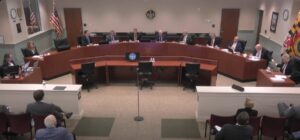 On October 8, 2024, Saint Mary’s County Commissioners held a joint meeting with the county’s delegation to the Maryland General Assembly. The meeting aimed to discuss key legislative proposals for 2025 and foster continued collaboration between county officials and state lawmakers. Attended by Senator Jack Bailey and Delegates Todd and Matt Morgan, the session brought to light a variety of proposals ranging from infrastructure funding to adjustments in local laws.
On October 8, 2024, Saint Mary’s County Commissioners held a joint meeting with the county’s delegation to the Maryland General Assembly. The meeting aimed to discuss key legislative proposals for 2025 and foster continued collaboration between county officials and state lawmakers. Attended by Senator Jack Bailey and Delegates Todd and Matt Morgan, the session brought to light a variety of proposals ranging from infrastructure funding to adjustments in local laws.
Commissioner President Randy Guy welcomed citizens and officials, emphasizing the importance of partnership between the commissioners and the delegation. Delegation Chair Todd Morgan noted the significance of ongoing legislative discussions in serving the interests of county residents.
“The purpose of tonight’s meeting is to provide the commissioners, the delegation, and the public an opportunity to hear and comment on the 2025 legislative proposals,” President Guy said. He also acknowledged Delegate Brian Crosby’s absence, but noted his participation in prior discussions.
Key Legislative Proposals for 2025
1. Public Facilities Bond Bill
The highlight of the discussion revolved around a $94 million bond proposal to fund capital improvement projects through fiscal years 2026 and 2027. However, this proposal was deferred until November, allowing more time for revision. Concerns were raised by both commissioners and delegation members about the high bond amount and its impact on county debt.
Several commissioners, including Mike Hewitt, emphasized the need to revisit the county’s debt levels, which are expected to quadruple by FY2027. Commissioner Hewitt noted that while revenues have increased, the county must tread cautiously when incurring new debt, particularly with rising interest rates and the potential for increased property taxes.
2. Animal Control Ordinance Flexibility
A major change was proposed to the county’s animal control statute, which currently mandates specific dog licensing requirements, including yearly renewal and the use of specific tags. The county seeks more autonomy to implement a more flexible system that better fits the needs of Saint Mary’s residents. John Hauser, Deputy County Attorney, explained that other counties already enjoy greater flexibility and Saint Mary’s should be added to that list.
The current prescriptive system has faced scrutiny from both county officials and residents, with the proposal aiming to simplify regulations and make licensing more efficient.
3. Comprehensive Water and Sewer Plan Amendment Process
Another significant proposal aimed at streamlining the process for amending the county’s comprehensive water and sewer plan. Current law requires two public hearings and a lengthy review process for even minor amendments. The proposed revision would remove the extra public hearing requirement, cutting down the time required by at least six weeks, which would be beneficial to developers and homeowners.
Commissioners noted that the current process adds unnecessary time and cost to smaller development projects, making this change essential for improved efficiency.
4. Procurement Threshold Increase
A proposal to raise the county’s procurement threshold from $15,000 to $50,000 was also discussed. The current threshold, dating back decades, has become outdated as prices have risen significantly. Raising the threshold would allow county departments more flexibility to handle smaller purchases without undergoing the full competitive bidding process, saving both time and resources.
This change would still require departments to adhere to competitive processes for larger projects, ensuring accountability while improving efficiency.
5. Alcohol Licensing Flexibility
The commissioners also considered a proposal to allow restaurant owners to hold more than one Class B beer, wine, and liquor license. This would spur economic development by enabling restaurateurs to expand to multiple locations across the county. The current one-license rule is seen as a barrier to entrepreneurship, particularly in the hospitality industry.
Additionally, a separate proposal from the Alcohol Beverage Board called for raising the maximum fine for liquor license violations from $1,000 to $2,500, allowing for greater deterrence and more proportional penalties for repeated violations.
Several proposals were deferred for further review, including:
The $94 million public bond bill, which will be revisited after November’s budget work session.
Proposals related to bus contractor fuel tax exemptions and multiple alcohol licenses will undergo additional consultations with the Alcohol Beverage Board and other stakeholders before being finalized.
The meeting concluded with a public comment session, where citizens expressed their views on the legislative proposals. Notably, Keith Harless spoke in favor of amending the county’s senior tax credit eligibility. He highlighted the unrealistic requirement of 40 years of homeownership to qualify and called for a reduction to 20 years, which would better reflect the realities of current housing trends. The commissioners noted they have the authority to make changes without state involvement and would consider the proposal.
John Walters, a member of the Saint Mary’s County Library Board of Trustees, proposed amending board member terms from five years to three years. While the commissioners deferred this proposal, they will seek input from the Library Board before making any decisions.
The joint meeting highlighted the strong working relationship between the commissioners and the county delegation. Both sides emphasized the need for collaboration and fiscal responsibility as they continue to refine the 2025 legislative agenda. While some proposals were deferred, others were well-received, setting the stage for ongoing discussions and improvements in county governance.
The next step for these proposals will involve further revisions and public consultations, with a final decision on most items expected in early 2025. Citizens were encouraged to stay engaged as these important legislative discussions unfold, helping shape the future of Saint Mary’s County.


